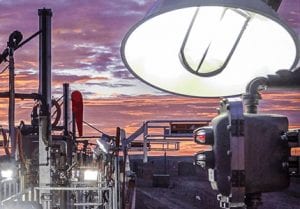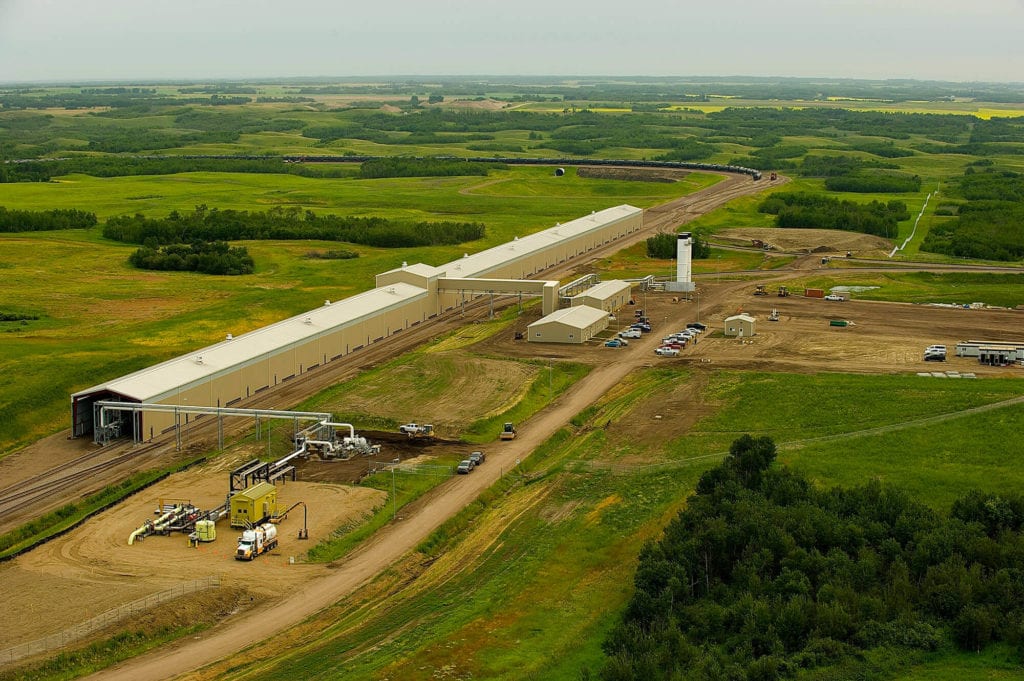Get a quote, configure a custom safety solution or ask a question. We're here to help!








- Spill ContainmentMore …Loading Safety CagesMore …
SafeRack Worldwide
We pride ourselves on one-on-one customer service. When you call SafeRack, we'll be there to answer your questions with a combined experience of 400+ years.
Select your region below.- View Products
- Railcar & Truck Loading Platforms
- Gangways & Loading Ramps
- Stairs, Platforms & Ladders
- Mobile Ladders & Platforms
- Loading Arms & Fluid Transfer
- Safety Gates & Traffic Control
- Aviation & Aerospace Access
- Marine Access & Loading
- Grounding & Monitoring
- Spill Containment
- Loading Safety Cages
- Transloaders & Skids
- Shelters & Canopies
- Fall Protection
- Terminal & Speciality
Home / Industries / Bulk Chemical Loading / Black Liquor HandlingBlack Liquor Handling Design, Loading, and Installation.
Although no two Black Liquor Loading solutions will be identical, the product itself determines much of the critical design criteria that will ensure that optimum safety and productivity can work together in harmony.
Black Liquor is the spent liquor from the Kraft process in which pulpwood is converted into paper pulp by removing lignin and hemicellulose elements and other extractable materials from wood chips to separate the cellulose fibers.








Question, Get a Quote, Live Demo or Request an On-Site Visit
Our experts simplify the complex
View Full TextIn the United States, Black Liquor is typically top loaded, through a stainless steel 4” loading arm with a vapor plate and 3” vapour return hose creating a “tight-fill” (closed-loop) loading operation. Black Liquor, if not handled properly can cause serious injuries (burns) and Personal Protective Equipment (PPE) is required. Additionally, because operators are on top of the vehicles during the loading process, robust, well-designed fall prevention is essential to ensure increased throughput, without compromising operator safety. In this instance,in terms of safety standards, OSHA General Duty Clause, Section 5(a)(1) is worth reviewing
Black liquor is typically transported in 26,000 gallon DOT-111 tank cars with safety valves that meet the DOT specification for the transportation of black liquor and other commodities. The rails cars themselves are ~ 9′ outside diameter with an overall length of ~45’ to 50′, with a 6’ x 6’ center opening or off-set crash box openings.
Tank truck (un)loading procedures are similar to railcar applications with the trailers meeting established DOT requirements for transporting Turpentine or other like commodities. Approved DOT trailers include MC 307 or low pressure chemical ISO containers. Trailers and ISO’s are typically bottom unloaded.
All trailers must be equipped with pressure relief valves; and trailers with bottom outlets must be equipped with remote controlled stop valves.
Typical Black Liquor Loading Platform
Quote or discuss your installation.
Start by selecting loading application"*" indicates required fields
Below are some of the loading and unloading solutions for illustrative purposes only. Our experts will work with you and your team for a custom solution to suit your needs.
Black Liquor Loading Arms
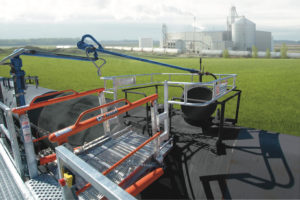
Black Liquor is typically loaded into railcars or tank trucks via a 4” boom supported stainless steel loading arm, with a 3” stainless steel vapor hose. The arm can also be designed to self-drain after each use. Other loading considerations may include: vapor line pressure switch to avoid over pressurization; Endress & Hauser Nivotester Liquifant high-level probe; parking latch and sensors, and bonding straps for electrical continuity. For unloading, black liquor is typically bottom unloaded via a rigid stainless steel, self-draining arm or 20’ flex hose with flanged ends or dry disconnect fittings.
Loading Gangways and Safety Cages


A wider access gangway (36″-48″ is preferable) as it helps improve access and egress to and from the vessel. In addition, a wider gangway will reduce the risk of the operator’s PPE getting caught, torn or damaged, and will improve productivity and safety. Powered gangway solutions are also an option, with both hydraulic and pneumatic solutions being commonly used. Each gangway will be fitted with a two-rail safety cage for the railcar crash box. This will be a centered 6’x6’ safety cage to sit directly over the cashbox. This will provide a safe, secure work environment for your operator when connected to their breathing apparatus
GX FLAT RAMP ACCESS (FRT) GANGWAY
SafeRack’s NEW GX-FRT is a flat ramp model popular with railcars. It features a slip-resistant walk surface and, with the use of the telescoping extension, eliminates gaps on narrow railcars. Learn More
Black Liquor Eye Wash/Drench Showers

ANSI guidelines state that an Eye Wash/Drench Showers need to be located 10 seconds or 55’ (16.8m) from contaminants or hazardous materials. Eyewash stations need to be on the same horizontal plane with no obstructions.
Therefore, we would propose the installation of a standard combination Drench Shower/Eyewash Unit, which will save limited space and fit easily into any work environment.
Black Liquor Spill Containment

Spill containment pans will be provided at the point of loading operations and is an essential piece of equipment in overall site safety and environmental protection Black Liquor Grounding

Black Liquor is not normally combustible. However risk of fire does exist in the presence of TRS gases. These fumes are flammable and can be ignited by heat or flame. Vapors have been known to travel back to ignition sources and flashback. - Vehicle grounding and bonding — ensure true grounding before product flow is permitted
- Explosion-proof enclosures — meet or exceed UL, CSA, and Ex requirements
- Non-sparking tools are also recommended while working around this product
Black Liquor Safety Gates

Safety Gates will be installed at the top of stairs and any other openings to ensure operator safety at all times.  YellowGate Safety Gates
YellowGate Safety GatesSafeRack’s line of industrial safety gates is the most flexible product on the market with the ability span openings between 16” and 36” and is field adjustable with nothing more than a wrench. Learn More
Black Liquor Options

- Lighting – Lighting both over and under the platform will be provided. For overcast days or second shift, lighting is essential for improved safety and improved productivity.
- Platform & Canopies – Full platform canopies reduce exposure to the elements and improve the safe and productive loading operation from the operator’s perspective.
- Operator Shelter – Depending on your site requirements, consideration should be given to the requirement of an operator or guard building on the loading platform. This can be customized to meet specific site requirements
- Wheel Chocks – Railcar Wheel Chocks provide fast blocking of all types of railcars and meet OSHA regulations to safely prevent railroad cars from moving during loading or unloading operations. This is a requirement by the Department of Homeland Security
Personal Protective Equipment PPE Requirements
Eye/Face Protection: Wear chemical safety goggles. A face shield (with safety goggles) may also be necessary.
Skin Protection: Wear chemical protective clothing e.g. gloves, aprons, boots. Coveralls or long sleeve shirts and pants in some operations. Wear a chemical protective, full-body encapsulating suit, and self-contained breathing apparatus (SCBA). Suitable materials include: butyl rubber, neoprene rubber, Viton®, Viton®/butyl rubber, Barrier® – PE/PA/PE, Silver Shield® – PE/EVAL/PE, Trellchem® HPS, Trellchem® VPS, Saranex®™, Tychem® BR/LV, Tychem® Responder® CSM, Tychem® TK. The following materials should NOT be used: natural rubber, polyvinyl chloride. Recommendations are NOT valid for very thin neoprene rubber gloves (0.3 mm or less).
Respiratory Protection: Up to 5 ppm:
(APF = 10) Any chemical cartridge respirator with cartridge(s) providing protection against chlorine*; or Any supplied-air respirator*.
*Reported to cause eye irritation or damage; may require eye protection.
APF = Assigned Protection Factor
Recommendations apply only to National Institute for Occupational Safety and Health (NIOSH) approved respirators. Refer to the NIOSH pocket guide to chemical hazards for more information.
Use a local exhaust ventilation and enclosure, if necessary, to control the amount in the air. Consider using a corrosion-resistant exhaust ventilation system separate from other ventilation systems. It may be necessary to use stringent control measures such as process enclosure to prevent product release into the workplace. Use backup controls (e.g. double mechanical pump seals) to prevent the release of this material due to equipment failure. * For illustrative purposes only. Our experts will work with you and your team for a custom solution to suit your needs Customer Reviews
 4 5I’m very pleased with the product and more importantly the service.
4 5I’m very pleased with the product and more importantly the service.Chris Hite was extremely responsive. He did an excellent job making sure that the gangway requested would meet our needs. We’ve found a new supplier and sales force that is willing and able to ensure our needs are met. I’m very pleased with the product and more importantly the service.
By Matt Pietrzykowski from SNF Flocryl on 2/15/11 5 5My product was delivered faster than expected.
5 5My product was delivered faster than expected.They were excellent. There was great follow through with all questions and billing issues. I even got a email just saying that Katie was still waiting to hear back from a vendor. Katie Kelly did a AWESOME job!!
One of the biggest selling points for me was the weight of the spill containment that I purchased. It was durable but light enough to easily be moved. I would definitely recommend this product as it fits the description 100%. It is very well built and will provide years of service to our company. All of my experience with the company was above standards and expectations. Everyone was fast to respond and very nice and respectful. The product was more than I expected and the price was very competitive.
By Erik Purvis from Remote Area Medical on 5/7/18 5 5We are very pleased with our ErectaStep Platform System
5 5We are very pleased with our ErectaStep Platform SystemGreat communication, updates, and customer service.
By Bob Cannon from Enterprise Products Partners on 3/16/20 4 5Quality is at the top of the industry in my opinion.
4 5Quality is at the top of the industry in my opinion.My dealings with SafeRack has always been positive. SafeRack personnel are always very easy to discuss items with and very responsive. Quality is at the top of the industry in my opinion. Delivery was as promised when the order was placed.
By Bruce Giesler from Mississippi Lime Co on 3/8/13 5 5The whole process was a positive one with very little issues.
5 5The whole process was a positive one with very little issues.I found that the equipment is very sturdy and built to the OSHA regulations. Its very easy to put together, I can trust it is built to code, the bright colors of the products makes it look very nice.
By Brady Heck from NUK USA LLC on 8/9/17 5 5Product fulfilled the customer’s expectations.
5 5Product fulfilled the customer’s expectations.The product was very simple and met all the specs that the customer requested. The SafeRack name is well know and respected. Product is very well made.
By Dan Logsdon from Choctaw Kaul Dist Co. on 5/31/17Black Liquor 101
Things to know about Black Liquor
Black liquor is a brown to black liquid with an odor similar to rotten eggs, and soluble in water. It’s a chemical mixture comprising an aqueous solution of lignin residues (and cellulose (both organic substances) and is the result or by-product of spent pulping liquor. Other product uses include burning the black liquor in the recovery boiler to reclaim certain pulping chemicals to be reused. Tall oil can also be extracted from the liquor.
Black liquor can cause severe skin burns, eye, and lung damage. As any caustic liquid, exposure to black liquor can cause coagulative necrosis that can lead to extensive tissue damage, as well as, damage to the respiratory system if mists or vapors are inhaled.
Caustic Kraft process liquors, under certain conditions, can produce toxic sulfur gases that include hydrogen sulfide, methyl mercaptan, dimethyl sulfide, and dimethyl disulfide. These gases are hazardous and their concentration will vary depending on whether the liquor is a strong or weak liquor. Regardless of the concentration, extreme care should be taken while working around these chemicals.
First aid measures for exposure include – removing operators from the source of exposure and into fresh air. Remove contaminated clothing immediately; wash skin thoroughly with soap and water; flush eyes with tepid water for 15 minutes. If ingested do not induce vomiting, but immediately call your local poison control center.
Avoid heat, flames, sparks and other sources of ignition. May ignite or explode on contact with combustible materials. Contact with acids may release potentially deadly concentrations of hydrogen sulfide gas. Black liquor is also incompatible with acids, most metals, and oxidizing materials.

Is your plant or facility compliant with ANSI, OSHA, and local safety codes? We can help!


EMERGENCY EYEWASHES / SHOWER EQUIPMENT AND THE ANSI/ISEA Z358.1 – 2014 STANDARD
Following eye contact, you must start washing with water immediately to prevent permanent damage. In the event of skin contact, you must start washing with water immediately to prevent slow-healing chemical burns.
Are you aware that ANSI guidelines state that Eye Wash/Drench Showers need to be located 10 seconds or 55′ from contaminates or hazardous materials and located on the same horizontal plane, with no obstructions? If bottom loading/unloading, an additional shower should be located at grade as well. SafeRack provides the above equipment plus much more needed to keep employees safe and expedite bulk chemical loading and unloading.
OSHA Regulation Experts – Does your existing chemical safety equipment or chemical loading systems meet OSHA’s latest requirements? SafeRack’s professional technical sales consultants are available to meet with your team to make recommendations to keep your facility in front of OSHA’s ever-changing country and region-specific standards and regulations, including lifeline and trolley beam fall arrest systems, metal stairs, and access platforms.
Installation Gallery
Why SafeRack?
The SafeRack approach is a collaborative one. Let’s call it The SafeRack Way. We have, over many years amassed a great deal of experience and understanding of the safety aspects involved in loading road tankers and railcars, as well as the behavioral habits of the operators.

Experts In Chemical Loading
- Acetic Acid
- Acetic Anhydride
- Acetonitrile
- Acrolein
- Acrylic Acid
- Acrylonitrile
- Aluminum Chloride
- Aluminum Sulfate
- Ammonia
- Ammonium Hydroxide
- Ammonium Nitrate
- Aniline
- Benzene
- Benzyl Chloride
- Bromotrifluoromethane
- Butadiene
- Carbon Dioxide
- Caustic
- Chlorine
- Chloroform
- Chlorosulfonic Acid
- DEF (Diesel Exhaust Fluid)
- Diethylene Glycol
- Dimethylformamide
- Dodecylbenzene Sulfonic Acid
- Ethanol
- Ethyl Acetate
- Ethyl Chloride
- Ethylene
- Ethylene Dichloride
- Ethylene Glycol
- Ethylene Oxide
- Ferric Chloride
- Ferrous Chloride
- Hexane
- Hydrochloric Acid
- Hydrofluoric Acid
- Hydrofluorosilicic Acid
- Hydrogen Cyanide
- Hydrogen Peroxide
- Hydrofluoric Acid
- Hypochlorous Acid
- Isopropyl Acetate
- Liquid Argon
- Liquid Nitrogen
- Liquid Oxygen
- Maleic Anhydride
- MDI
- Methanol
- Methyl Chloride
- Methyl Ethyl Ketone
- Methyl Methacrylate
- Methyl Isocyanate
- Molten Sulphur
- Nitric Acid
- Oleum
- Phenol
- Phosphoric Acid
- Phosphorus Oxychloride
- Phosphorus Trichloride
- Polypropylene
- Renewable Diesel
- Sodium Cyanide
- Sodium Hydroxide
- Sodium Hypochlorite
- Styrene Monomer
- Sulfuric Acid
- Sulfur Dioxide
- Titanium Tetrachloride
- Toluene
- Toluene Diisocyanate
- Turpenitne
- UAN (Urea Ammonium Nitrate)
- UREA
- Vinyl Acetate
- Vinyl Chloride
- Xylene
- Zinc Chloride
- Agro-Chemical
- Specialty Chemical
- Petrochemical

North America’s largest loading terminal
World-leading designer, manufacturer, and installer of truck and railcar loading platforms
As one of the primary railcar loading points, Hardisty is one of the major crude oil hubs in North America and a major origination point of pipelines that export to the United States. SCS was asked to supply and construct a SafeRack crude oil loadout terminal spanning nearly half a mile. The USD Hardisty terminal can load up to two 120-railcar unit trains per day and consists of a fixed loading rack with 62 railcar loading positions enclosed, separate control, operator, and mechanical buildings, as well as a unit train staging area and loop tracks capable of holding multiple unit trains simultaneously. SCS also supplied and installed boom-supported loading arms with supply and vapor management systems.

Quick Quote 866-761-7225
LET US DESIGN YOUR SOLUTION TODAY
Our innovative tools provide 3D visualizations and accurate quotes in minutes.
Get Help NowOrder Now 866-761-7225
Questions or Need a Quote?
Chat live with a knowledgeable and friendly safety expert now.

Bob Kashtan
Located in South Carolina

Joey Robinson
Located in South Carolina

Caelin Lacy
Located in South Carolina

Katie Kelly
Located in South Carolina

Amber Graham
Located in South Carolina













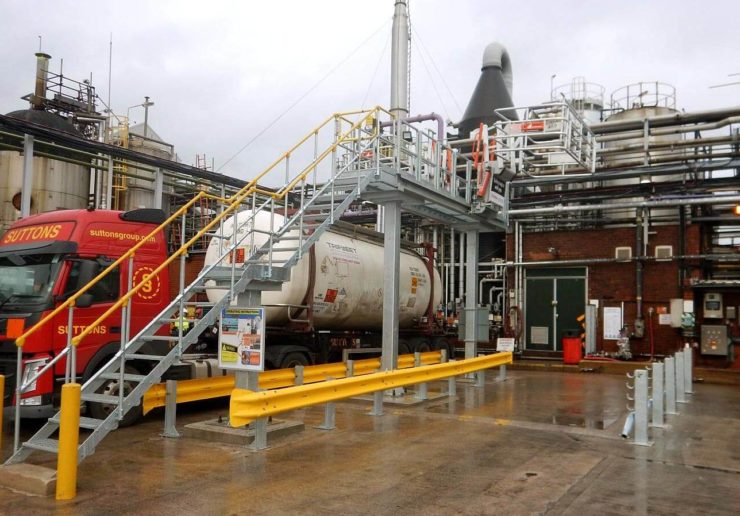
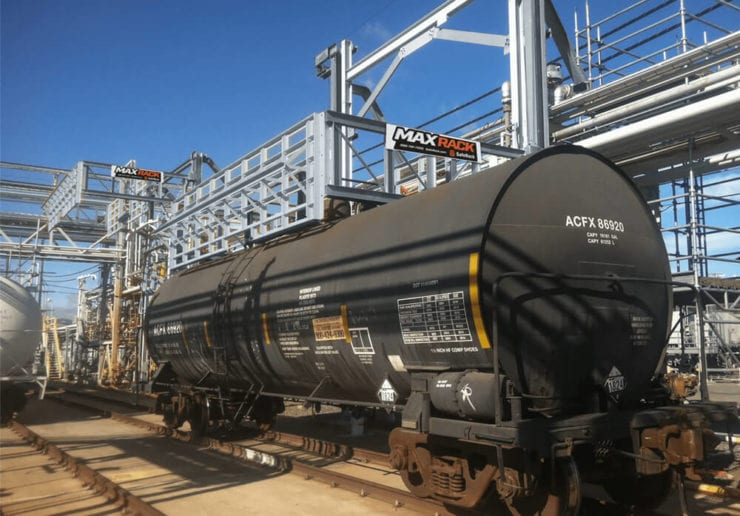


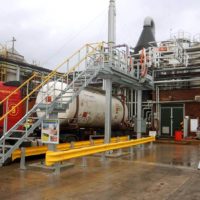
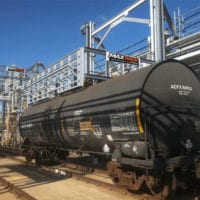
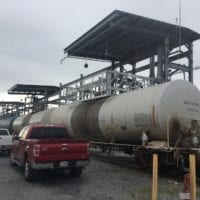
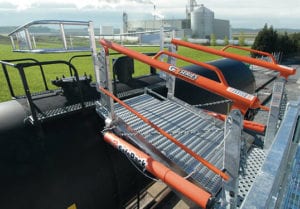
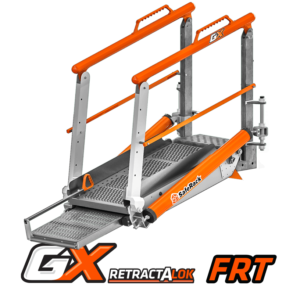
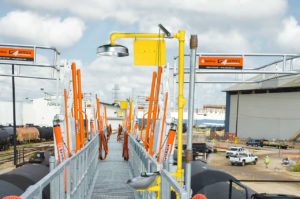
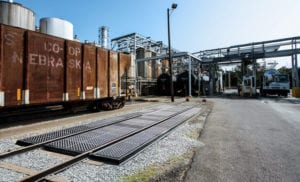
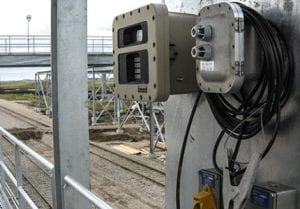
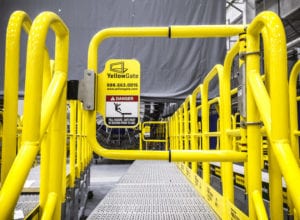
 YellowGate Safety Gates
YellowGate Safety Gates